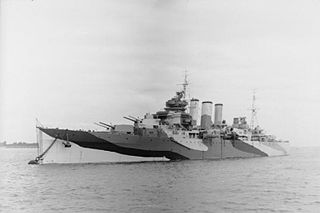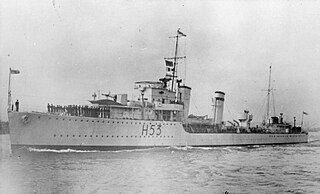
HMS Garland, also known by her Polish designation ORP Garland, was a G-class destroyer built for the Royal Navy in the mid-1930s. During the Spanish Civil War of 1936–1939 the ship spent considerable time in Spanish waters, enforcing the arms blockade imposed by Britain and France on both sides of the conflict. Shortly after World War II began, she was badly damaged by the premature explosion of her own depth charges and required over six months of repairs. Before these were completed, Garland was loaned to the Polish Navy in May 1940. The ship was assigned to the Mediterranean Fleet afterwards and escorted convoys there before being assigned to the Western Approaches Command in September for escort duties. She escorted a convoy from Gibraltar to Malta during Operation Halberd in September 1941 and escorted Convoy PQ 16 from Iceland to Murmansk in May 1942. She was badly damaged by a near miss from a German bomber during that operation and required three months of repairs.

HMS Glasgow was a Town-class cruiser commissioned in September 1937. She took part in the Fleet Air Arm raid that crippled the Italian Fleet at Taranto in 1940. She had the unfortunate experience of sinking two Allied ships during her wartime service, once through accidental collision and the other by gunfire after a case of mistaken identity.

HMS Ajax was a Leander-class light cruiser which served with the Royal Navy during World War II. She became famous for her part in the Battle of the River Plate, the Battle of Crete, the Battle of Malta and as a supply escort in the siege of Tobruk. This ship was the eighth in the Royal Navy to bear the name. In February 1942, she was adopted by the civil community of Halifax, West Yorkshire.

The C and D class was a group of 14 destroyers built for the Royal Navy in the early 1930s. As in previous years, it was originally intended to order a complete flotilla comprising eight destroyers—plus a flotilla leader as the ninth unit—in each year. However, only four ships—plus a leader—were ordered under the 1929–1930 Programme as the C class. The other four ships planned for the C class were never ordered as an economy measure and disarmament gesture by the Labour government of Ramsay MacDonald. A complete flotilla—the 'D' class—was ordered under the 1930–1931 Programme.

HMAS Hobart was a modified Leander-class light cruiser which served in the Royal Australian Navy (RAN) during World War II. Originally constructed for the Royal Navy as HMS Apollo, the ship entered service in 1936, and was sold to Australia two years later. During the war, Hobart was involved in the evacuation of British Somaliland in 1940, fought at the Battle of the Coral Sea and supported the amphibious landings at Guadalcanal and Tulagi in 1942. She was torpedoed by a Japanese submarine in 1943, then returned to service in 1945 and supported the landings at Tarakan, Wewak, Brunei, and Balikpapan. Hobart was placed in reserve in 1947, but plans to modernise her and return her to service as an aircraft carrier escort, training ship, or guided missile ship were not followed through. The cruiser was sold for scrapping in 1962.

HMS Shropshire was a Royal Navy (RN) heavy cruiser of the London sub-class of County-class cruisers. She is the only warship to have been named after Shropshire, England. Completed in 1929, Shropshire served with the RN until 1942, when she was transferred to the Royal Australian Navy (RAN) following the loss of sister ship HMAS Canberra. Commissioned as HMAS Shropshire, the ship remained in RAN service until 1949, and was sold for scrap in 1954.

Montcalm was a French La Galissonnière-class cruiser, named in honour of Louis-Joseph de Montcalm. During World War II, she served with both Vichy France and the Allies. It was commissioned in 1937, decommissioned in 1957, and finally scrapped in 1970.

HMS Tartar was a Tribal-class destroyer of the Royal Navy that saw service in most of the naval theatres of World War II. She had an eventful career, eventually receiving the nickname 'Lucky Tartar' due to her numerous escapes from dangerous situations. She was one of only four from the sixteen Royal Navy-operated Tribal-class destroyers to survive the war.

The Shoreham-class sloops were a class of eight warships of the Royal Navy built in the early 1930s.

HMS Decoy was a D-class destroyer of the Royal Navy. Ordered in 1931, the ship was constructed by John I. Thornycroft & Company, and entered naval service in 1933. Decoy was initially assigned to the Mediterranean Fleet before she was transferred to the China Station in early 1935. She was temporarily deployed in the Red Sea during late 1935 during the Abyssinia Crisis, before returning to her duty station where she remained until mid-1939. Decoy was transferred back to the Mediterranean Fleet just before the Second World War began in September 1939. She briefly was assigned to West Africa for convoy escort duties in 1940 before returning to the Mediterranean. The ship participated in the Battles of Calabria without significant damage and escorted ships of the Mediterranean Fleet for most of the rest of the year.

HMS Capetown was a C-class light cruiser of the Royal Navy, named after the South African city of Cape Town. So far she has been the only ship of the Royal Navy to bear the name. She was part of the Carlisle group of the C-class of cruisers.

HMS Carlisle was a C-class light cruiser of the Royal Navy, named after the English city of Carlisle. She was the name ship of the Carlisle group of the C-class of cruisers. Carlisle was credited with shooting down eleven Axis aircraft during the Second World War and was the top scoring anti-aircraft ship in the Royal Navy.

HMS Dainty was a D-class destroyer built for the Royal Navy in the early 1930s. The ship was initially assigned to the Mediterranean Fleet before she was transferred to the China Station in early 1935. She was temporarily deployed in the Red Sea during late 1935 during the Abyssinia Crisis, before returning to her assigned station where she remained until mid-1939. Dainty was transferred back to the Mediterranean Fleet just before World War II began in September 1939. She briefly was assigned to West Africa for convoy escort duties in 1940 before returning to the Mediterranean. The ship participated in the Battle of Calabria in July 1940 and was assigned to convoy escort and patrol duties until she was sunk by German bombers off Tobruk on 24 February 1941.

HMS Kimberley was a K-class destroyer of the Royal Navy. She served in the Second World War and survived it, being one of only two of the K-class to do so. So far she has been the only ship of the Royal Navy to bear the name Kimberley, after the town of Kimberley, Northern Cape, site of the Siege of Kimberley in the Second Boer War. She was adopted by the civil community of Eastwood, Kimberley and Selston, Nottinghamshire in 1942 after a successful Warship Week campaign for National Savings.

HMS Vivacious (D36) was a V-class destroyer of the British Royal Navy that saw service in World War I and World War II.

HMS Versatile (D32) was an Admiralty V-class destroyer of the British Royal Navy that saw service in World War I, the Russian Civil War, and World War II.

The third HMS Windsor (D42) was a W-class destroyer of the British Royal Navy that saw service in the final months of World War I and in World War II.

HMS Viceroy (D91) was a W-class destroyer of the British Royal Navy that saw service in the final months of World War I and in World War II.

The second HMS Wivern, was a Modified W-class destroyer of the British Royal Navy that saw service in World War II.

The eighth HMS Worcester, was a Modified W-class destroyer of the British Royal Navy that saw service in World War II. She later served as an accommodation ship as the second HMS Yeoman.




















